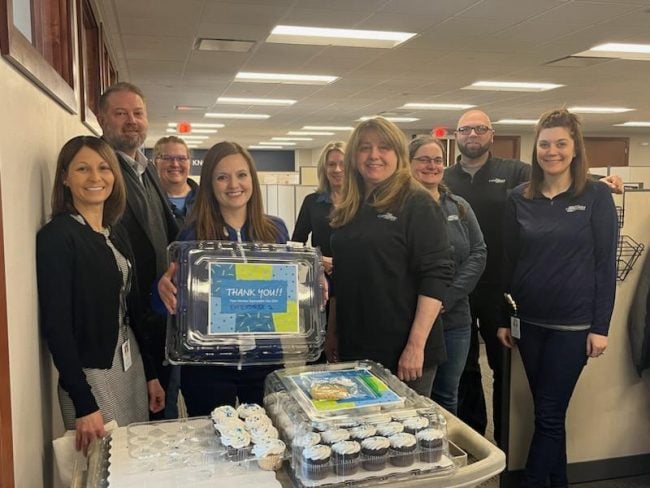 Ken McGlamery hasbeen in the financial advisory business for 25 years and for thefirst time in his career, he's seeing more clients who are wellinto their 90s.
Ken McGlamery hasbeen in the financial advisory business for 25 years and for thefirst time in his career, he's seeing more clients who are wellinto their 90s.
“When I talk to clients, I factor in how much things will costwhen they're 90 years old,” said McGlamery, who is a financialadviser with CUNA Brokerage Services Inc., serving members at the$1.3 billion Vantage West Credit Union in Tucson, Ariz. “Lifeexpectancy – now, it's about how to make the wealth last muchlonger.”
|According to some estimates, approximately 10,000 boomers perday will reach retirement age over the next 20 years, with manyseeking financial advice for this critical time in their lives.
|The landscape for retirement has certainly changed as womencontinue to outlive men, more adult children are returning home tolive with or care for their elderly parents, pensions havedownsized, and fears grow on whether Social Security will still bearound in the next decade or so.
|Those layers of worries have altered the way financial advisersare serving credit union members. Once upon a time, a conversationwould include talk about annuities and rates of return. Now, it canbe dividing assets among divorced boomers who cohabit under thesame roof. McGlamery has been involved in the latter.
|“They're still living together to survive financially. Normally,I'm just advising one (person in the couple),” McGlamery said. “Inthese situations, I'll ask about income, how much you owe on yourmortgage, how's the cash flow. Every situation is unique.”
|McGlamery and two other advisers travel between Vantage West's17 branches to meet with members. The credit union's investmentprogram has been around for roughly 15 years but in January,Vantage West Financial Advisors partnered with CUNA Brokerage afterleaving a long-time alliance with a leading broker-dealer. Thedivision has $70 million in assets under management, according toMcGlamery. Business has been so brisk that the program is lookingto hire a fourth adviser, he added.
|Vantage West was chartered in 1955 as DMAFB Federal Credit Unionto serve military and civilian personnel working at Davis-MonthanAir Force Base in Tucson. Many of the members are retired militarylike McGlamery, a former Navy pilot who transported people back andforth to carriers, and the bulk of the adviser program's clientsare in the boomer age range.
|“Vantage West has many loyal members who are baby boomers,” saidBob Ramirez, president/CEO of the credit union. “Making investmentservices available inside Vantage West branches continues ourlegacy of community banking, while at the same time injectingfinancial investment muscle and expertise into the mix.”
|The good news is more members are in a position to retire andmaintain their current lifestyles, McGlamery noticed. For those whohave to work past retirement age, they're doing so with paid-offmortgages and less debt.
|“When you retire, it's just about cash flow. There aren't a lotof pensions out there now. For some folks, it's just savings andSocial Security,” McGlamery said. “The key is to get your debt paidoff. You may be at a point where you will have to work parttime.”
|Read more: The Great WealthTransfer
|Over the next 30 to 40 years, boomers willtransfer $33 trillion to Gen X and Gen Y, according to TheGreat Wealth Transfer, a 2012 report from Accenture. McGlamerysaid he is definitely seeing an increase in inheritance transfers.One of his first clients, a 90-year-old member who recently passedaway, left a substantial inheritance that is currently beingdivided up among three children.
|For those that see Social Security as their primary means tolive on during retirement, McGlamery said he's most concerned forthe generations coming after the boomers.
|“I read that by 2033, the Social Security trust will be driedup,” he noted. “Gen X will have to pay taxes into that trust fund.I call it a pig in the python. It's moving along slowly but at somepoint, it will need to be addressed.”
|Social Security is a huge concern for some of the boomers at the$598 million Red Canoe Credit Union in Longview, Wash., said HelenAlexander, vice president of wealth management and a CBSI financialadviser. So much so that it continues to be a hot topic at creditunion quarterly seminars and during on-site sessions at selectemployee groups.
|“There are stages of their concerns, especially when (boomers)are getting to retire. They want to know if they're going to haveenough to live on,” Alexander said. “They've been in the mode ofsaving for so long but now, they're not sure how to get to it.”
|Alexander said some members who work with Red Canoe's team offinancial advisers tend to fall into two groups: those who've savedand are petrified to spend and those who have so much money thatthey think it will last forever. Depending on their situation, shemay have to give a nudge to those in the first group to reassurethem that it's OK to use their savings – even it's for a little,fun splurge. For the spenders, a hard discussion on clamping downtypically brings them back to financial reality.
|Besides Social Security, healthcare expenses are anotherpressing issue for some Red Canoe members, Alexander noticed.
|“Over the last year and a half, health care reform has created alot of confusion,” she said. “Some companies that used to providehealth care for retirees have stopped. We're teaching (them) how tonavigate the state of Washington website to apply forcoverage.”
|Another growing trend is adult children who need more financialsupport to care for their parents or to pay for assisted carefacility costs, Alexander said. On the flip side, last week, shemet with four clients who were raising their grandchildren butdidn't plan on the new role at this point in their lives and werein dire need of financial assistance.
|Like McGlamery, Alexander said she is starting to see a steadystream of inheritance scenarios.
|“It's a little overwhelming for some people because they say,'what do I do with it?' They want to honor it because their mom anddad worked hard for it. So, they'll do things like pay off theirdebt or help their kids pay off their debt. I may have met with oneor two clients that were like, 'Woo hoo, let's have a bigparty.'”
|Red Canoe's adviser program has been around for more than 15years and has $100 million in assets under management, Alexandersaid. Roughly 50% to 60% of the program's clients are boomers, sheadded. At first, she would either meet with a male client or acouple. Now, as clients get older, she's seeing more females whocome alone or have taken over handling the finances because theirhusbands don't have the mental capacity to do so.
|“With a lot of the women, they have this fear that they will beimpoverished. Much of my job is educating them on what they have,”Alexander said.
|Indeed, women are outliving men and the questions they have suchas when to start drawing on retirement benefits continue to weighheavily on their long-term planning, said Terry Colen, CBSI seniorfinancial adviser and trust liaison officer at the $1.7 billionTruliant Federal Credit Union in Charlotte, N.C.
|“Longevity creates health insurance issues. They want to know'when do I take Social Security,' 'when can I touch my IRA,' and'do I even have enough money set up in retirement,'” Colen said.“Financial planning becomes risk management.”
|In place since 1995, Truliant's financial adviser program hasamassed $190 million in assets under management, Colen said. Sevensalaried advisers work with members and nearly 70% of those clientsare in the boomer age range, he added. Many of them are engineersand expect top-notch expertise, he pointed out.
|Biggest issues for Truliant's boomers: how to navigate SocialSecurity and health care costs. Members need hand-holding when itcomes to the Medicare and Medigap maze and the conditions on whento take certain parts, and how leaving an employer can lock up anychances of getting in during an open enrollment period. Colen saidmonthly seminars address these topics along with long-term care andtrust estate planning.
|Colen has a startling way of helping boomers see the bigpicture.
|“As advisers, we should kill them, fire them or have them liveto 100,” he explained. “By that, I mean if you die tomorrow, whogets your kids? What if your spouse dies? Do you have a will? Ifyou left your job tomorrow, how much money would you have to liveon? Do you know anyone who is 80 or 90 years old? How much willthings cost when they reach 100? They come in for retirementplanning but we want to do life planning.”
|Colen said generally, he only sees inheritance situations incases of premature death. What's more prevalent is when a boomerhas a special needs child or ensuring beneficiary designations areup to date, especially in blended families.
|“When I started out 25 years ago, it was the best annuity orrate of return. That's irrelevant. Now it's, 'How can I make surethat my grandchildren are taken care of if something happens tome.'”
Complete your profile to continue reading and get FREE access to CUTimes.com, part of your ALM digital membership.
Your access to unlimited CUTimes.com content isn’t changing.
Once you are an ALM digital member, you’ll receive:
- Critical CUTimes.com information including comprehensive product and service provider listings via the Marketplace Directory, CU Careers, resources from industry leaders, webcasts, and breaking news, analysis and more with our informative Newsletters.
- Exclusive discounts on ALM and CU Times events.
- Access to other award-winning ALM websites including Law.com and GlobeSt.com.
Already have an account? Sign In
© 2024 ALM Global, LLC, All Rights Reserved. Request academic re-use from www.copyright.com. All other uses, submit a request to [email protected]. For more information visit Asset & Logo Licensing.









